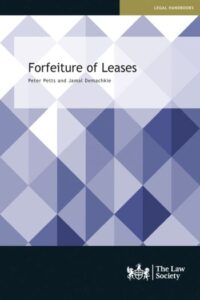Business Lease Renewal editor and freelance property law trainer Sarah Thompson-Copsey reviews Forfeiture of Leases by Peter Petts and Jamal Demachkie, published by The Law Society.

Sarah Thompson-Copsey
As we start to see the easing of some of the statutory restrictions on forfeiture of leases, introduced to protect tenants during the coronavirus pandemic, this is a very timely and useful guide for practitioners in the field, in the context of both commercial and residential leases. The authors are both practicing barristers with many years practical experience in landlord and tenant law and this is evident in the in-depth and yet intensely practical approach they take to this complex area of law in their book.
In spite of a number of unsuccessful attempts by the Law Commission to bring about reform and simplification of the law of forfeiture, this is still a landlord’s remedy that is “complex, it lacks coherence, and it can lead to injustice” . Forfeiture of Leases goes a long way to unravelling such complexities for the busy practitioner, whether acting for landlord or tenant.
Forfeiture of Leases is not, however, a ‘how to’ guide for the beginner, but very much more of an authoritative text for the more experienced practitioner. It takes the reader through the various steps’ to consider in deciding whether to use this most draconian of landlord remedies before looking, in depth, at many of the tricky areas and practical problems experienced by practitioners.
The book contains very useful guidance on some of these trickier areas, including how to handle leases without forfeiture clauses, ascertaining whether there has been a breach (particularly difficult with alienation, but very fully covered here, although I was slightly surprised at the omission of the pithy comments on the distinction between occupation and possession, of Floyd J in ANSA Logistics Ltd v Towerbeg [2012] EWHC 3651 (Ch)), and how to avoid some of the potential traps around the drafting of the s146 notice.
Waiver, an area fraught with practical difficulties, particularly with regard to acceptance and demand of rent(s) is very comprehensively and clearly dealt with. There is a very useful, detailed section on landlord’s ‘knowledge’ of the breach, including the recent Court of Appeal comments in Faiz v Burnley Borough Council [2021] EWCA Civ 55, as well as on timing of conduct amount to waiver. The book also offers very practical tips on the question of handling automated transfers and cheques as well as on appropriation.
“…this is a very timely and useful guide for practitioners in the field.”
Some very useful, and welcome, guidance on the practical exercise of peaceful re-entry is also given. Relief from forfeiture is also very comprehensively covered, and includes the reminder that relief requires a court under in light of Zestcrest Limited v County Hall Green Ventures Limited [2011] 50 EG 60. This section also includes not only the recent clarifying Court of Appeal decision of Keshwala v Bhalsod [2021] EWCA 492 on timing of application for relief, but also very usefully covers the tricky area of 3rd party rights including the knotty problem of the interaction between the grant of a new lease and the subsequent revival of the old lease.
There is, additionally, a very timely chapter on the impact of tenant insolvency on a landlord’s right to forfeit, which includes the new Part A1 Moratorium introduced under the Corporate Insolvency and Governance Act 2020. The book also draws together the statutory restrictions surrounding, and provides useful guidance for those involved in, the forfeiture of long residential leases.
At the back of the book two useful annexures contain a precedent s146 notice and a wide-ranging selection of essential statutory extracts. The book does not deal with restrictions on forfeiture under the Coronavirus Act 2020 nor under the Commercial Rent (Coronavirus) Bill 2021/22, which is sensible in view of the short-lived nature of such restrictions.
***
 For more about this book and purchasing, click here.
For more about this book and purchasing, click here.
FULL DETAILS:
Forfeiture of Leases, Peter Petts and Jamal Demachkie
Published by The Law Society
£110.00 (ISBN 9781784461546)

